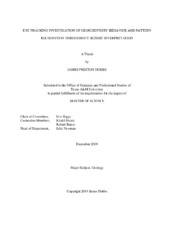| dc.description.abstract | This study was designed to understand the seismic interpretation workflows employed by graduate level geoscientists, and to identify behaviors and practices consistent with higher levels of expertise, through the use of eye tracking data collection and analysis. This mixed-methods study recorded pre-professional graduate level geoscientists of varying levels of expertise to characterize workflows displaying techniques leading to higher quality interpretations. Eye tracking video recordings were analyzed to identify patterns, similarities, and differences among the approaches each participant took when completing the seismic interpretation exercise. Responses from background surveys and post-exercise interviews were incorporated to provide additional background information regarding experience in order to more fully assess participant expertise, as well as gain insights into thought processes employed during the exercise. Information from the surveys, interviews, and workflows behaviors observed during the seismic interpretation exercises were used to place participants into different levels of expertise. The data was investigated to identify trends and themes among the various expertise groups. Our results show the lower expertise participants had less experience with seismic interpretation in the forms of lacking formal coursework, taking part in projects or having industry experience. In addition to the seismic interpretation experience acquired through coursework, group projects and industry experience, the higher expertise participants used descriptive writing to communicate concepts of their geologic narratives useful in constructing a geologic evolution of the dataset. Higher expertise individuals were more successful in constructing the geologic evolution of the dataset by employing interpretational elements like relating events in geologic time, describing geologic processes and building a sequence stratigraphic framework.
This study was able to show that consistent patterns emerge from observing gaze points based on individual participant habits and on feature type. Insights from this study will help to guide future research aiming to assess workflow behavior over a broader range of expertise and interpretation through computer software. | en |


